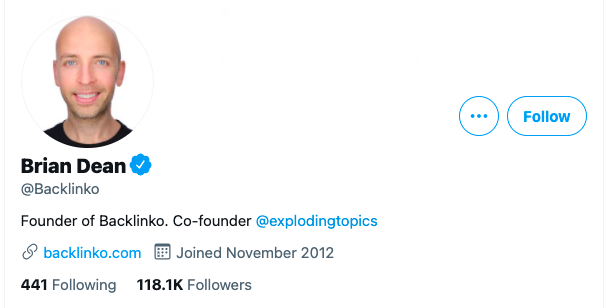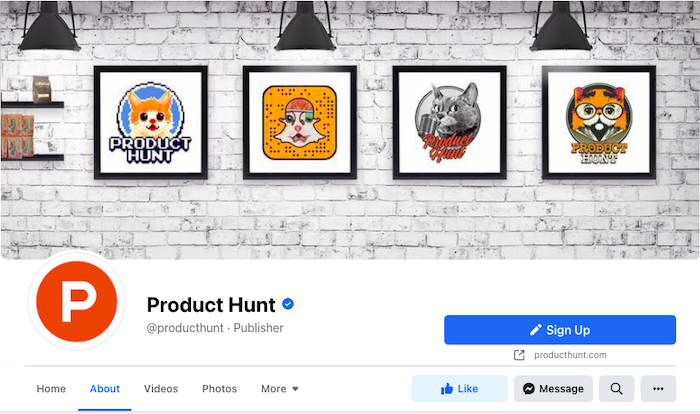
Having good social media profiles can get you more exposure online, help you connect with your fans or customers, and improve your online reputation.
Unless you have a major site associated with your name (like NeilPatel.com), your social media profiles are usually the first results Google shows when someone searches for you.
Start thinking of each social media profile you create as a landing page for your personal brand.
Your social media profiles are possibly the first encounter that someone is going to have with your brand, and you want that first impression to make the visitor interested in knowing more about you.
Here are 10 elements of successful social media profiles.
Element #1: Your Social Media Profile Display Name
Okay, this seems fairly basic. The name that displays on your social media profile should just be your own name, right?
Usually, that’s correct. However, sometimes that doesn’t make the most sense.
On platforms like Twitter, where you don’t have to use a real name, a pseudonym might make more sense.
Element #2: Your Social Media Username and URL
On most social networks, your username is included in your URL, and it’s often different from your display name. Usually, you can’t change your username, so choose it carefully.
If possible, it’s usually best to just go with your own name. Sometimes, if you’re the face of your company, the company name might work better.
On Twitter, Brian Dean isn’t @briandean but @Backlinko, since that’s the name of his company.

Finally, while it isn’t always possible, try to keep your username the same across platforms.
It can be confusing when this isn’t the case, like Instagram being @yourname and Twitter being @yourcompany or @yourmiddlename.
Element #3: Your Social Media Profile Picture
Should you go with a logo or a personal picture?
Of course, if it’s for a personal account, you should almost always go with a headshot.
What about for a company? It’s a tough call, but it really depends on your goals. If you run a smaller operation or are the face of your company, include a headshot of you.
That’s what Brian does on Twitter, even with his company usernames. This also applies to people that are brands themselves, like musicians, artists, or politicians.
If you have a more recognizable brand or don’t want your company to be associated with you specifically, go with the logo.

It’s also a good idea to stick with the same (or at least a similar) photo across different social networks. That way you’re easier to recognize on different platforms.
Element #4: Your Social Media Profile Link
This varies from one social media network to the next, but be sure to seek out any opportunity to get your link on the main page of your social profile.
For example, you can add a link on the “front page” of your profiles on Twitter and LinkedIn.
Make sure that your link is front and center so that people can find it quickly and click through to your website.
Another good idea for your links is to create a social network-specific landing page so you can track which profiles are bringing your site the most traffic.
You can use these pages to offer a special discount for people who have found you on Twitter or share information that is specific to a network, like recent blog posts you have written about Facebook.
Element #5: Your Social Media Profile Bio
Your main social profile bio should usually include a sentence or two about yourself or your business. Think of it as a perfect place to put your elevator pitch and include keywords.
In a few words, what would you say about your business? It’s also a good idea to use your bio to its fullest potential. Some sites, like Twitter, only let you write a short description.
If you’re on a platform like LinkedIn, your “about” section can have up to 2,000 characters. This is a huge opportunity to explain what you’re all about and make a great first impression.
To make this succeed, you’ll want to add more than just a simple description of what you’ve done and your current projects. Instead, create a story with a basic call to action.
For example, you can tell how you started with the industry you’re working in. What got you interested in it, and what makes you stick around and keep learning?

Finally, you can finish your bio with a simple call to action. This can be a link to a free report, an offer for someone to call you, or even a mission statement asking “will you join me?”
Element #6: Your Social Media Profile Interests
Some profiles allow you to have additional extended information about yourself in the form of favorite books, television shows, movies, and so on.
A lot of people skip over this, especially when it comes to business profiles, but that is a big mistake.
Look at these fields as an additional place to get some great value and connections
I doubt there is a niche out there that doesn’t have at least one or two published books.
Find books, documentaries, and profiles of influential people in your industry and add those in these additional fields (assuming you actually enjoy them, of course!)
This adds credibility and a new level of connection you can build with people who are learning about you for the first time.
Element #7: Your Social Media Profile Background or Cover Image
Different platforms have different requirements, but most social networks today have some way to add a larger image behind your main profile page.
Some users, especially on Twitter and LinkedIn, choose to use the default background image, but this is a mistake.
A customized background will allow you to share additional information and give personality to you or your brand.
Don’t make it distracting or more important than your profile picture, but a great cover image can go a long way to personalizing your social page.

On some platforms, like Facebook, this can even be a video. If you have the option (and decent video), this can be even an even more engaging way to connect with others.
Element #8: Your Social Media Profile Privacy Settings
After you have all of your profile filled out and pictures uploaded, the next thing that you will need to take a look at is your privacy settings.
These vary from network to network, but you will want to make sure that the information you would like to be public is viewable.
Chances are, if this is a business-related profile, you’ll want almost everything to be public. Of course, if your profile is more personal nature, you may want to hide some things.
Element #9: Your Social Media Activity
Once your profile setup is complete, your on-going mission will be to maintain a healthy level of activity on your main social networks.
It’s not enough to leave a profile blank. You need to contribute to the platform and build connections. After all, that’s what they’re there for in the first place.
No matter what social network you’re on, the basic guidelines still apply. You’ll want to connect with friends and followers by asking questions and responding to comments.
Provide value by posting interesting ideas, or at least sharing interesting and relevant things you find.
If you’re in any groups, become an active participant. Be helpful, connect with others in the group, and share things the group will find interesting.
Element #10: Your Social Media Promotion
Finally, there is nothing like a little healthy promotion of your social network profiles to help more people find and connect with you.
Be sure to add your social networking profile links to your website, email signature, and business card.
Also, don’t forget to interlink your profiles to each other. Many networks have places to include links to other networks, and you can and should use them whenever possible.
Stay connected, become an active member on the social network of your choice, and you’ll start acquiring a following.
Social Media Profile FAQs
This depends on what you do. If you have a personal profile or your brand centers around who you are, use a headshot. If you have a business where you aren’t the face, your logo will work well.
Using the same name is ideal but not always possible. If your username is taken on another platform, then use something very similar.
Your social media bio should have everything people need to know about your brand. Let them know what makes your brand stand out, what you do, and a call to action whenever possible.
You can brand your social media profile by using a custom cover image with your brand colors and logo. You can also put important information in your cover image. On some platforms, you can also add your interests. This is a great way to add a personal touch.
You can cross-promote your social media profile with each other, by adding all of your links to each profile. You can also all links to your website, and email campaigns.
Social Media Profiles Conclusion
If you’re getting started with social media marketing, the first step is to set up your accounts and profiles correctly.
If you’ve already been in the game for a while, it’s probably time to take a look at the profiles you set up.
Are there ways to improve what you already have online? Is the profile picture you uploaded last year still relevant? Does your bio or link need updating?
Since it’ll be the first impression many people see, it’s worth spending some time to improve your social media presence and make it compelling and interesting.
What strategies have you used to improve your social media profile?
The 10 Elements of a Successful Social Media Profile
Publicado Primeiro em Neil Patel
Nenhum comentário:
Postar um comentário